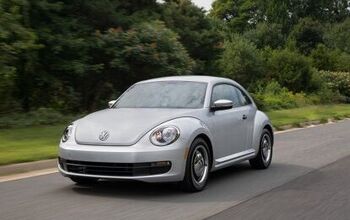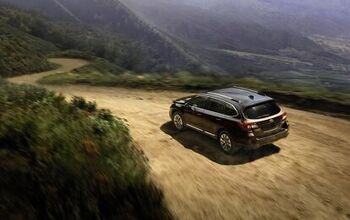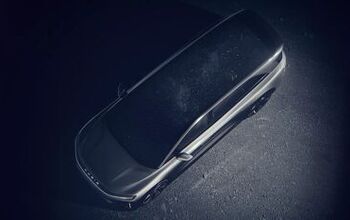Piston Slap: That One!

Kiwi writes:
Howdy Sajeev. I’m looking to the general crowd of enthusiasts and experts here to give me some advice. I am most assuredly not a car expert myself.
We have three cars, two of which are a 2000 Toyota Camry (177k miles) and a 2000 Chevy Blazer (78k miles). The Camry is my daily car, and I drive 55 miles round trip to work five days a week (sometimes more as I have night school twice a week). The Blazer is my mother-in-law’s car, and she drives very little, mainly just to pick up my daughter from school a couple of times a week (less than 10 miles round trip), down to the local shops, etc. We are up in the PA/NJ area.
On the face of it, if we were ready to turn one of these in it’d be the Blazer, right? Except that little SUV feels like a total lemon. The door doesn’t fit right, we just had to replace the transmission (our fault, admittedly, because we held off replacing a bad gasket for too long – but now that’s a few thousand dollars invested in it), the gas gauge isn’t working properly, and now the main cabin electrics seem to be acting up. There’ve been other mechanical issues, but these are the most recent.
What my mom-in-law really wants is a Ford Explorer like she used to have. She loathes the Blazer (hand down from my wife when she got a new car a few years later). My wife and I think we could put out about $10k or $12k to go for a used Escape – Explorers at that price point seem to be getting a bit older and/or higher mileage (upwards of 100k).
So, dear experts, what is the recommended course of action? Bin the Blazer before it breaks blatantly and go for an Escape? Hold on to it until it goes really tragic? The Camry (knock on wood) has been very good to me so far, but I don’t know if it’s getting to a point where I can expect seriously expensive repairs. (The timing belt was just replaced again within the past 10k miles, but I was told the water pump was fine – it has been replaced in the past.) And realistically I do not have the skills/knowledge/tools/time to do any maintenance myself, on any of the cars. Remember the Blazer’s main function is to ferry my daughter around as needed. Thanks all!
Sajeev answers:
I google’d your Blazer to make sure it was “that one.” Oh boy. Don’t get me wrong; the first-gen Blazers were crude and cheerful. The later TrailBlazers are well sprung with a great I-6 motor, sporting an absolutely horrid interior. But those? Aside from use as a work rig, they are significantly worse in terms of design and dynamic performance: the original incarnation’s glovebox door doubling as an HVAC register personifies this design’s “asleep at the wheel” attitude.
If the mom-in-law doesn’t like it, also consider the piss-poor IIHS offset crash scores, even compared to the Firestone-fettled deathtrap Explorers of the same era. If you sell it to someone wanting a cheap truck for truck-ish use, everyone will be happy. But you’ll be lucky to get $3500 for it, even if gas prices trend downward. Is a newer Escape worth the extra $8-10 grand?
From a product standpoint, most definitely. The interior is far nicer, performance and economy are worlds apart and safety ratings seem better…ignoring the weight disadvantage of the little CUV. But from a financial standpoint? Going into (extra?) debt isn’t the brightest idea for most in this economy, but I’ll let you decide that on your own.
Send your queries to mehta@ttac.com. Spare no details and ask for a speedy resolution if you’re in a hurry.

More by Sajeev Mehta
Latest Car Reviews
Read moreLatest Product Reviews
Read moreRecent Comments
- Sobhuza Trooper That Dave Thomas fella sounds like the kind of twit who is oh-so-quick to tell us how easy and fun the bus is for any and all of your personal transportation needs. The time to get to and from the bus stop is never a concern. The time waiting for the bus is never a concern. The time waiting for a connection (if there is one) is never a concern. The weather is never a concern. Whatever you might be carrying or intend to purchase is never a concern. Nope, Boo Cars! Yeah Buses! Buses rule!Needless to say, these twits don't actual take the damn bus.
- MaintenanceCosts Nobody here seems to acknowledge that there are multiple use cases for cars.Some people spend all their time driving all over the country and need every mile and minute of time savings. ICE cars are better for them right now.Some people only drive locally and fly when they travel. For them, there's probably a range number that works, and they don't really need more. For the uses for which we use our EV, that would be around 150 miles. The other thing about a low range requirement is it can make 120V charging viable. If you don't drive more than an average of about 40 miles/day, you can probably get enough electrons through a wall outlet. We spent over two years charging our Bolt only through 120V, while our house was getting rebuilt, and never had an issue.Those are extremes. There are all sorts of use cases in between, which probably represent the majority of drivers. For some users, what's needed is more range. But I think for most users, what's needed is better charging. Retrofit apartment garages like Tim's with 240V outlets at every spot. Install more L3 chargers in supermarket parking lots and alongside gas stations. Make chargers that work like Tesla Superchargers as ubiquitous as gas stations, and EV charging will not be an issue for most users.
- MaintenanceCosts I don't have an opinion on whether any one plant unionizing is the right answer, but the employees sure need to have the right to organize. Unions or the credible threat of unionization are the only thing, history has proven, that can keep employers honest. Without it, we've seen over and over, the employers have complete power over the workers and feel free to exploit the workers however they see fit. (And don't tell me "oh, the workers can just leave" - in an oligopolistic industry, working conditions quickly converge, and there's not another employer right around the corner.)
- Kjhkjlhkjhkljh kljhjkhjklhkjh [h3]Wake me up when it is a 1989 635Csi with a M88/3[/h3]
- BrandX "I can charge using the 240V outlets, sure, but it’s slow."No it's not. That's what all home chargers use - 240V.































Comments
Join the conversation
I'm not sure just how set she is on SUV's (sounds like she's in love with the idea), but you'd be able to choose between some really economical and reliable vehicles if you could talk her down to cars. For the same money you'd be able to shop vehicles with far better passive safety most importantly (your daughter!). As for active safety, I think that, older drivers especially, are far better drivers when not perched high off the ground and insulated from all sensation of relative speed, not to mention the roll-over on side impact tendencies of older SUV's (sliding into a guardrail for instance). There are plenty of awd and fwd cars out there, and you already have an "expensive to own" vehicle, so you could probably get something spec'd relatively well and still have the same cost of ownership.
Simple sell both buy the MIL an SUV - don't worry about the mpg, look for an unloved model - Mitusbishi Endeavor? Then lease something for yourself - Hyundai Elanta ($1500 down + $169 /month). Swap cars a couple of times a month to balance the milage on the lease (12000 per year)